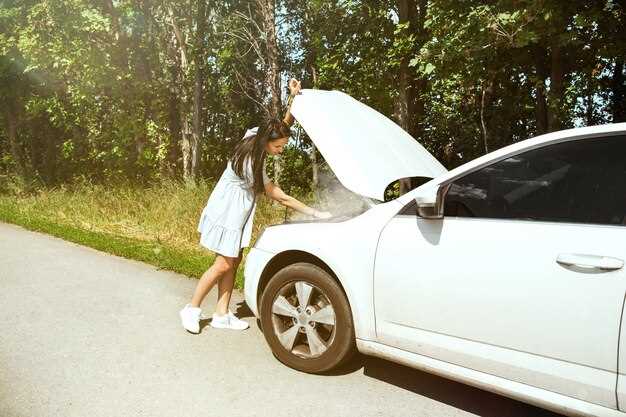Experiencing a car breakdown can be a stressful and often dangerous situation. Whether you’re on a busy highway or a quiet back road, knowing how to handle such an event safely is crucial. In this article, we will explore practical tips to help you manage a breakdown effectively while minimizing risks to yourself and others.
First and foremost, it is essential to remain calm and assess the situation. Understanding the cause of the breakdown can help you determine the appropriate course of action. If the vehicle is still operational, move it to a safe location away from traffic. Being visible is vital; turning on your hazard lights alerts other drivers to your presence and warns them to slow down.
Once you have secured your vehicle, prioritize your safety by staying inside the car if you are on a busy road. Exiting the vehicle can expose you to potential hazards. If you need to leave the car, make sure to choose a safe spot away from traffic and ensure that you are fully aware of your surroundings. Remember, staying alert is key in such unpredictable situations.
By implementing these strategies, you can effectively manage a car breakdown while prioritizing safety for yourself and others on the road. Stay tuned as we delve deeper into additional steps you can take and resources available to assist you during this challenging time.
Assessing Your Situation Before Taking Action
When you experience a car breakdown, the first step is to assess your situation carefully. Understanding your environment and the nature of the breakdown will dictate your next steps. Here are key points to consider:
- Location:
- Determine whether you are on a busy road or in a more isolated area.
- Identify nearby landmarks or exit points for safety assessment.
- Traffic Conditions:
- Observe the flow of traffic. Are other vehicles moving swiftly or slowing down?
- Assess if your vehicle poses a hazard to traffic.
- Time of Day:
- Consider whether it’s day or night, as visibility will affect your safety.
- If it’s dark, be extra cautious about your surroundings.
- Weather Conditions:
- Take note of the weather. Rain, snow, or fog can complicate your situation.
- Assess how these conditions might impact your ability to seek help.
- Vehicle Status:
- Check if any unusual smells or sounds indicate mechanical issues.
- Assess if it’s safe to exit the vehicle to inspect it further.
- Personal Safety:
- Consider your safety before leaving the vehicle, especially if on a busy road.
- Stay inside the vehicle if you feel unsafe or if it’s not advisable to exit.
After evaluating these factors, you will be better equipped to make a decision regarding your next steps, whether it’s calling for roadside assistance, attempting a minor repair, or preparing for an emergency evacuation.
Steps to Take Immediately After Your Car Stops
Experiencing a car breakdown can be stressful, but taking the right steps can ensure your safety and the safety of others on the road. Here are essential actions to take right after your vehicle stops.
| Step | Description |
|---|---|
| 1. Remain Calm | Take a moment to compose yourself. Panic can lead to hasty decisions that may worsen the situation. |
| 2. Assess Your Surroundings | Check your environment for potential hazards, such as busy roads, visibility issues, or weather conditions. |
| 3. Signal Other Drivers | Turn on your hazard lights to alert other motorists that your car is disabled and that they should exercise caution. |
| 4. Move to Safety | If possible, steer your vehicle to the shoulder or another safe location away from traffic. |
| 5. Exit the Vehicle Carefully | If you need to leave the car, do so carefully, preferably from the side away from oncoming traffic. |
| 6. Set Up Warning Devices | If you have warning triangles or flares, set them up at a safe distance from your vehicle to alert other drivers. |
| 7. Contact For Assistance | Use your mobile phone to call for roadside assistance or emergency services, providing them with your location and situation. |
| 8. Wait for Help | Stay with your vehicle if it is safe to do so, as it provides a barrier between you and traffic until help arrives. |
How to Safely Signal for Help on the Road
When you find yourself stranded on the side of the road due to a car breakdown, signaling for help is essential. Here are effective ways to ensure your safety while attracting assistance.
1. Stay Calm and Assess Your Situation:
- Stay inside your vehicle if it is safe to do so. This provides protection from oncoming traffic.
- Turn on your hazard lights to alert other drivers to your situation.
2. Use Road Flares or Warning Triangles:
- If available, set up road flares approximately 30-50 feet behind your vehicle.
- Alternatively, place a warning triangle at the same distance to increase visibility.
3. Utilize Reflective Vests:
- If you have a reflective safety vest, put it on to ensure you are visible while waiting for help.
- This is particularly important if you need to stand outside your vehicle.
4. Signal for Help:
- Raise a white cloth or a bright-colored item, such as a jacket, to attract attention.
- Wave your arms or use hand signals to indicate you need assistance.
5. Use Your Mobile Phone:
- If you have service, call for roadside assistance or emergency services.
- Provide your exact location to ensure help can find you quickly.
6. Avoid Standing Near Traffic:
- Remain inside your vehicle as much as possible if it is deemed safe.
- If you need to exit, do so cautiously and remain away from the roadway.
By following these steps, you can effectively signal for help while prioritizing your safety on the road during a breakdown.
Preparing an Emergency Kit for Future Breakdowns

Having a well-equipped emergency kit is essential for anyone who spends time on the road. An organized emergency kit can make a significant difference during a car breakdown situation. Here are the key components to include in your emergency kit:
1. First Aid Supplies: Ensure your kit contains basic first aid items, such as adhesive bandages, antiseptic wipes, gauze pads, adhesive tape, scissors, and pain relievers. This will help address minor injuries while awaiting professional assistance.
2. Tools and Repair Items: Keep a basic tool set that includes items such as a wrench, screwdriver, pliers, tire jack, and jumper cables. A tire repair kit is also useful for addressing flat tires on the spot.
3. Flashlight and Extra Batteries: A reliable flashlight is crucial for visibility in low-light situations. Make sure to include extra batteries or opt for a rechargeable flashlight that can be powered through your vehicle’s charging port.
4. Reflective Warning Triangle and Road Flare: These items help alert other drivers to the presence of your vehicle, enhancing safety. Place them behind your vehicle to increase visibility, especially at night or during poor weather conditions.
5. Warm Blankets and Clothing: In case of breakdowns in colder weather, include a few warm blankets and extra clothing items like gloves and hats. These can keep you comfortable while waiting for help.
6. Non-Perishable Snacks and Water: Keeping granola bars, dried fruits, or nuts stored in your kit provides sustenance if you are stranded for an extended period. Pack a few bottles of water to stay hydrated.
7. Phone Charger and Portable Power Bank: A car charger for your phone is vital if you need to contact roadside assistance. A portable power bank can serve as a backup to keep your devices charged when your car battery is low.
8. Emergency Contact Information: Keep a list of important phone numbers, including roadside assistance, family members, and your insurance provider. It’s also helpful to have a map in case your GPS is unavailable.
Having a comprehensive emergency kit designed for breakdown situations enables you to tackle unexpected road issues with confidence. Regularly check the contents of your kit and replenish items as needed to ensure you are always prepared.
Choosing the Right Mechanic for Repairs

Selecting the appropriate mechanic for your vehicle repairs is crucial to ensure your car receives the best possible service. Start by asking for recommendations from trusted friends, family, or coworkers who have had positive experiences. Their insights can guide you to reputable professionals in your area.
Next, consider checking online reviews and ratings on platforms such as Google, Yelp, or social media. Pay attention to customer feedback regarding reliability, honesty, and quality of work. A business with consistently high ratings is likely to be a solid choice.
Verify the mechanic’s certifications and qualifications. Look for those who are ASE (Automotive Service Excellence) certified, as this indicates a standard of knowledge and experience in the automotive field. Mechanics with specific training related to your vehicle’s make can be even more beneficial.
When you visit a shop, assess the environment. A clean, organized, and well-equipped garage suggests professionalism and attention to detail. Don’t hesitate to ask questions about the repair process, warranties, and parts used. A trustworthy mechanic will be open to discussing these topics and addressing your concerns.
Lastly, get a written estimate before any work begins. This document should clearly outline the necessary repairs, parts, and labor costs. A reliable mechanic will provide transparency and ensure you understand what you are paying for, helping to prevent any surprise charges later.
Understanding Roadside Assistance Options
Roadside assistance can be a lifesaver when you experience a car breakdown. Understanding the available options helps you make an informed decision about which service best meets your needs.
1. Membership Programs: Many automobile clubs offer roadside assistance as part of their membership packages. These programs often provide a wide range of services, including towing, fuel delivery, and flat tire changes. Joining a club can be beneficial for frequent travelers and can also offer discounts on various automotive services.
2. Insurance Coverage: Check your auto insurance policy; some providers offer roadside assistance as an add-on. This option can be cost-effective if you already have coverage, as it may come at a lower rate than standalone services. Be aware of the limitations, such as the number of service calls allowed per year and specific types of coverage.
3. Credit Card Benefits: Certain credit cards include complimentary roadside assistance services. Review your credit card perks to see if this benefit applies. This can be a convenient option since no additional cost is required, but ensure you understand the terms and conditions associated with the service.
4. Standalone Services: Many companies offer standalone roadside assistance programs, which can be purchased separately from other services. These plans typically provide 24/7 support and a variety of services but may require a yearly or monthly fee. Compare different providers to find one that offers the best coverage for your needs.
5. Mobile Apps: Technology has introduced mobile apps that connect users with roadside assistance services on demand. These apps often provide real-time tracking and can facilitate a faster response time. However, ensure that the app is from a reputable provider to avoid potential scams.
In conclusion, understanding the various roadside assistance options available can help you choose the most appropriate solution for your circumstances. Evaluate the features, costs, and benefits of each choice to ensure peace of mind while on the road.

